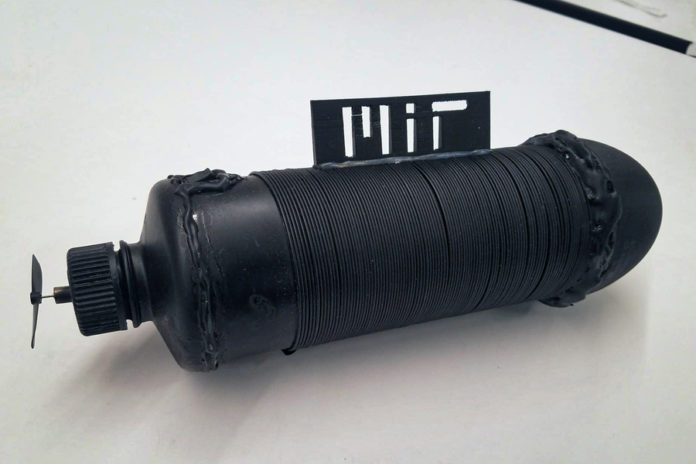Batteries look very simple at first glance. In general, their fabrication is almost always the same: a cathode and an anode are sepearated by an electrolyte; a structure that enables electrons to flow and to be stored. The thing is, not only are most modern battery designs cylindrical, but their fabrication increasingly requires several stakes as batteries increasingly serve multiple applications.
One of the latest applications that experts want to democratize is the use of batteries in wearable devices. A research of MIT engineers in the field saw the development of a rechargeable lithium-ion battery in the form of an ultra-long fiber that could be woven into fabrics.
The battery could enable a wide variety of wearable electronic devices, and might even be used to make 3D-printed batteries in virtually any shape, they say. The project required to explore new possibilities for self-powered communications, sensing, and computational devices that could be worn like ordinary clothing, as well as devices whose batteries could also double as structural parts.
Prior to this research, it had been demonstrated that fibers contain a wide variety of electronic components, including light emitting diodes (LEDs), photosensors, communications, and digital systems. Many of these are weavable and washable, making them practical for use in wearable products, but all have so far relied on an external power source. Now, this fiber battery, which is also weavable and washable, could enable such devices to be completely self-contained.
The new fiber battery is manufactured using novel battery gels and a standard fiber-drawing system that starts with a larger cylinder containing all the components and then heats it to just below its melting point. The material is drawn through a narrow opening to compress all the parts to a fraction of their original diameter, while maintaining all the original arrangement of parts.
While others have attempted to make batteries in fiber form, Khudiyev says, those were structured with key materials on the outside of the fiber, whereas this system embeds the lithium and other materials inside the fiber, with a protective outside coating, thus directly making this version stable and waterproof. This is the first demonstration of a sub-kilometer long fiber battery which is both sufficiently long and highly durable to have practical applications, he says. (Tural Khudiyev is an MIT postdoc and one of the lead authors of this research).
The fact that they were able to make a 140-meter fiber battery shows that “there’s no obvious upper limit to the length. We could definitely do a kilometer-scale length,” he says. A demonstration device using the new fiber battery incorporated a “Li-Fi” communications system — one in which pulses of light are used to transmit data, and included a microphone, pre-amp, transistor, and diodes to establish an optical data link between two woven fabric devices.
“When we embed the active materials inside the fiber, that means sensitive battery components already have a good sealing,” Khudiyev says, “and all the active materials are very well-integrated, so they don’t change their position” during the drawing process. In addition, the resulting fiber battery is much thinner and more flexible yielding an aspect ratio, that is the length-to-width fraction, up to a million, which is way beyond other designs, which makes it practical to use standard weaving equipment to create fabrics that incorporate the batteries as well as electronic systems.
The 140-meter fiber produced so far has an energy storage capacity of 123 milliamp-hours, which can charge smartwatches or phones, he says. The fiber device is only a few hundred microns in thickness, thinner than any previous attempts to produce batteries in fiber form.
In addition to individual one-dimensional fibers, which can be woven to produce two-dimensional fabrics, the material can also be used in 3D printing or custom-shape systems to create solid objects, such as casings that could provide both the structure of a device and its power source. To demonstrate this capability, a toy submarine was wrapped with the battery fiber to provide it with power. Incorporating the power source into the structure of such devices could lower the overall weight and so improve the efficiency and range they can achieve.
“This is the first 3D printing of a fiber battery device,” Khudiyev says. “If you want to make complex objects” through 3D printing that incorporate a battery device, he says, this is the first system that can achieve that. “After printing, you do not need to add anything else, because everything is already inside the fiber, all the metals, all the active materials. It’s just a one-step printing. That’s a first.”
The team has already applied for a patent on the process and continues to develop further improvements in power capacity and variations on the materials used to improve efficiency. Khudiyev says such fiber batteries could be ready for use in commercial products within a few years.
Remember, you can post job opportunities in the AM Industry on 3D ADEPT Media free of charge or look for a job via our job board. Make sure to follow us on our social networks and subscribe to our weekly newsletter : Facebook, Twitter, LinkedIn & Instagram ! If you want to be featured in the next issue of our digital magazine or if you hear a story that needs to be heard, make sure you send it to contact@3dadept.com






